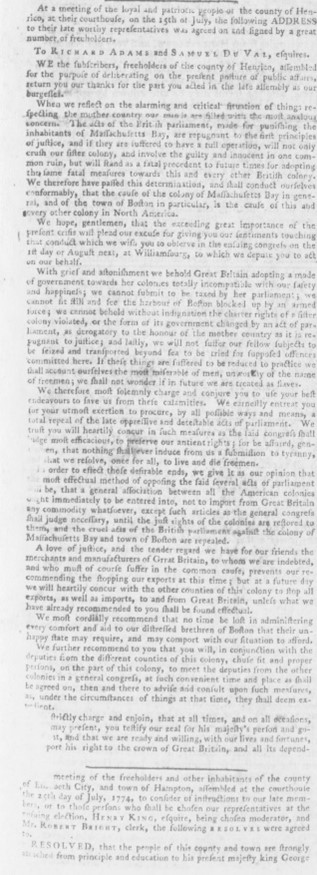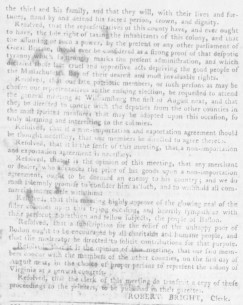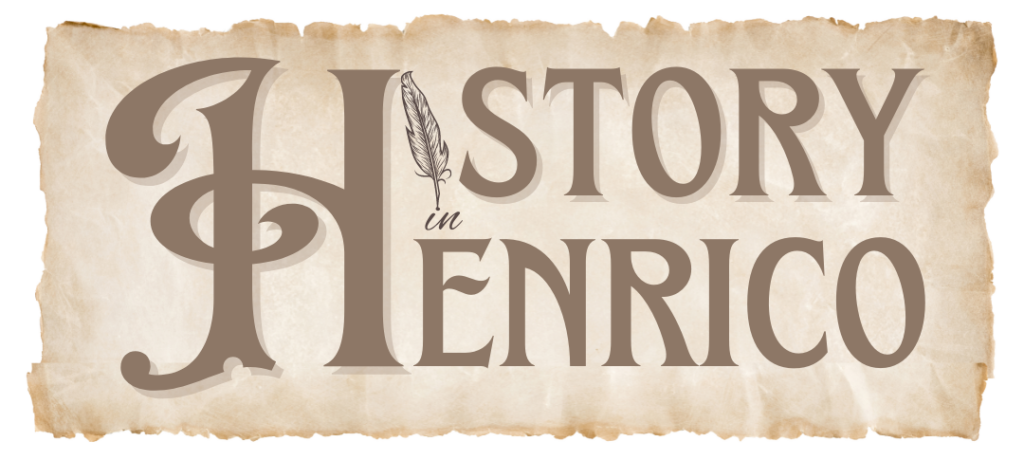
VA250 commemorates the 250th anniversary of the American Revolution, the Revolutionary War, and US Independence in the Commonwealth of Virginia.
Henrico County’s VA250 committee is part of these larger state and national efforts to recognize the people and events of the American colonies fight for independence and its founding through an ongoing series of programs, events, and projects.
While state and federal efforts may peak in 2026, Henrico County will continue offering a variety of ways to learn about the people and events of the past as well as to engage in dialogue on what liberty, freedom, and how the legacy of events 250 years ago shape the present and what our citizens hope to see for the future.
Traveling Exhibits
Un/Bound: Free Black Virginians, 1619-1865
Explores the lives of free Black Virginians from the arrival of the first captive Africans in 1619 to the abolition of slavery in 1865. Through powerful objects and first-person accounts, visitors will discover how Virginia’s people of color achieved their freedom and persevered within a legal system that recognized them as free but not equal.
- Eastern Henrico Rec Center (Nov 10 – 16)
Determined: The 400-Year Struggle for Black Equality
Traces four centuries of Black history in Virginia through stories of extraordinary individuals who struggled for equality and, in the process, profoundly shaped the nature of American society and the meaning of our collective ideals.
Their stories help us to understand the origins of today’s problems and to reckon with the painful legacies of slavery, segregation, and white supremacy. These determined individuals also inspire us to create a better future.
- Eastern Henrico Rec Center (Feb 9 – 22)
- Deep Run Rec Center (Feb 23 – Mar 1)
- Meadow Farm Museum (Mar 4 – 8)
- Belmont Rec Center (Mar 9 – 15)
- Rec & Parks Main Office (Mar 16 – 22)
Programs
Gingerbread for Liberty
Fri, Nov 21, 5-6:30pm. Belmont Rec Center.
All ages. Celebrate National Gingerbread Cookie Day on November 21 by going back in time 250 years! Munch on some gingerbread cookies while listening to the children’s book, Gingerbread for Liberty. Discover the fascinating story of how a gingerbread baker helped George Washington win the war. Create gingerbread themed crafts and activities that will spice up your day with combining fun and history! Information: [email protected]
Benedict Arnold: American Patriot, American Traitor
Sun, Jan 11, 2-3:30pm. Belmont Rec Center.
Ages 10+. Today, the name Benedict Arnold is synonymous with treason and is reviled throughout the United States. However, before he “turned” and took up arms against his countrymen, Major General Arnold was the most aggressive and successful officer in the Continental Army. Hear Benedict Arnold explain why he abandoned the American fight for independence and went over to the British side, and his destructive January 1781 raid against the important rebel supply depot of Richmond, Virginia. Information: [email protected]
Historians on Tap: Uncivil Wars
Thur, Jan 15, 6:30-8pm. Blue Bee Cider.
Ages 16+. Local historians will dive into tales of eccentric characters and unusual events from the Civil War era, revealing the unexpected ways the era shaped our community. Information: [email protected]
Spilling the Tea on Colonial Tea
Sun, Jan 25, 2-3:30pm. Belmont Rec Center.
All ages. Why did the British and their colonies become tea drinkers? How was colonial tea service different from Victorian? Did anyone drink tea from the saucer? See the types of tea available to colonists, including substitutes used during the boycott. There will be a demonstration of how tea was prepared, including the common implements of the time. Information: [email protected]
Timeline
| 1752 | Henrico County’s courthouse moves from Varina to Richmond in the middle of East Main and 22nd streets. |
| May 1752 | Reverend William Stith, of Henrico, makes one of the earliest public protests on taxation without representation, protesting Royal Governor Dinwiddie’s policy of charging one Spanish pistole to place his official seal on land patents without the consent of the Virginia Assembly. |
| May 31, 1767 | British chancellor of the Exchequer Charles Townshend introduces in the House of Commons his program to tax the colonies. |
| April 2, 1768 | Henrico residents send a petition to the House of Burgesses claiming that the Townshend Act taxes infringe on the rights of free citizens. Journals of the House of Burgesses of Virginia, 1766-1769, pg 145 (Sat, the 2nd of April. 8 Geo. III. 1768) |
| July 27, 1769 | Anne Randolph (Wilton) and Lucy Randolph (Chatsworth) have their names in the Virginia Gazette signing nonimportation pacts. |
| May 1769 | Governor Boteourt dissolves the House of Burgesses due to their protests. |
| Dec 14, 1769 | Over 100 women wear homespun gowns to a ball in Williamsburg to protest British tax policy. |
| May 24, 1774 | Virginia House of Burgesses declares a day of prayer and fasting to protest British taxes. |
| July 28, 1774 | The Virginia Gazette publishes the Henrico Resolves in support of the Massachusetts colony and in response to Parliament’s creation of the Coercive Acts, also referred to as the Intolerable acts in the colonies.  |
| Aug 1, 1774 | First Virginia Convention in Williamsburg convenes with Richard Adams and Samuel DuVall representing Henrico. |
| Nov 17, 1774 | Henricoans gather at the courthouse based on agreements set by Continental Congress earlier that fall to elect a county committee “to observe the conduct of all persons touching this association” and publish information on individuals violating it. |
| Mar 20, 1775 | Second Virginia Convention convenes at St. John’s Church. Reverand Miles Seldon of Henrico is appointed chaplain and Henrico again is represented by Richard Adams and Samuel DuVal. |
| Mar 23, 1775 | Patrick Henry delivers “Give Me Liberty or Give Me Death” speech. |
| Mar 25, 1775 | George Washington visits Anne Randolph at Wilton Plantation in eastern Henrico after attending the Second Virginia Convention. |
| Apr 21, 1775 | Governor Dunmore orders the seizure of gunpowder stored in the public magazine at Williamsburg. |
| Apr 26, 1775 | The Henrico committee responds to the seizure of gunpower, claiming that removing the gunpowder was “an insult to every freeman in this country.” |
| Jun 14, 1775 | The Second Continental Congress establishes the Continental Army and elects George Washington its commander the following day. |
| July 17, 1775 | The Third Virginia Convention meets at St. John’s Church with Richard Adams and Richard Randolph representing Henrico. |
| Nov 6, 1775 | Henrico elects 21 men to a committee to enact measures adopted by Continental Congress, Va Convention & Committee of Safety. |
| Nov 7, 1775 | John Murray, the Earl of Dunmore and Virginia’s royal governor, issues a proclamation to free enslaved and indentured servants able and willing to serve in the British army. |
| Nov 1775 | Lord Dunmore’s Ethiopian regiment forms, providing military training and arms for the first Black military unit raised by the British in North America. |
| Dec 1775 | Armed men raid homes in Henrico County stealing salt, a valuable food preservative. |
| Dec 1-10, 1775 | One company of the Henrico Battalion activate into service (led by Captain William DuVal) at Williamsburg. They remain there until discharged on March 6, 1776. |
| Dec 9, 1775 | Battle of Great Bridge in Norfolk County results in an American victory. |
| Dec 28, 1775 | 5th Virginia Infantry Regiment forms in Richmond partially consisting of troops from Henrico. |
| Feb 1776 | Henrico conducts a survey of residents and reports 500 men of military age in the county. |
| Feb 24, 1776 | The 3rd Company of the 5th VA Regiment under Capt. John Pleasants is organized in Henrico County. This regiment will fight at the battles of Trenton, Princeton, NJ; Brandywine and Germantown, PA; Monmouth, NJ; and Charleston, SC. |
| Jun 29, 1776 | The General Assembly elects Patrick Henry as Virginia’s first governor. |
| Aug 5, 1776 | By order, Henrico’s sheriff reads the Declaration of Independence in front of the county courthouse. |
| May 28, 1776 | Robert Pleasants writes to Governor Patrick Henry, requesting those who wish to free their enslaved laborers be allowed to do so. |
| May 12, 1779 | The 5th Virginia, consisting of Henrico soldiers, consolidates into the 3rd Virginia Infantry Regiment. |
| July 12, 1779 | The Virginia Assembly votes to move capital from Williamsburg to Richmond. |
| June 10, 1780 | “Sentiments of an American Woman,” calling on American women to organize and collect donations for Continental Army soldiers, is published. The document becomes the foundation of the Philadelphia Ladies’ Association, as well as a similar voluntary organization in Virginia. Martha Washington serves as the organizations’ chief treasurer, and Virginia women collect over $100,000. |
| Jan 4, 1781 | British General Benedict Arnold leads troops down New Market Road, skirmishes at Chimborazo Hill with local men, then advances to Richmond, burning the town and its supplies. Watch Video |
| Mar 1, 1781 | Maryland ratifies the Articles of Confederation after Virginia agrees to relinquish its western land claims. |
| Apr 27, 1781 | British General Arnold’s troops destroy the entire Virginia State Navy during the Battle of Osborne’s Landing. |
| Apr 30, 1781 | British and American forces exchange artillery fire across the James River, with the British in Manchester and the Americans in Richmond. |
| May 3, 1781 | French aristocrat the Marquis de Lafayette, serving as a Major General in the Continental army, moves troops to Bottoms Bridge in eastern Henrico. |
| May 26, 1781 | British troops under General Cornwallis cross the James River from the south and march over Malvern Hill, moving north to Hanover County. |
| Jun 18-20, 1781 | Cornwallis’s troops march from the west into Richmond, occupy it, and move on toward Williamsburg by way of Bottoms Bridge. |
| Late July 1781 | Lafayette and Virginia militia camp at Malvern Hill for about two weeks. |
| Oct 19, 1781 | The Siege of Yorktown concludes with the British surrendering to Continental and French forces, effectively ending major military operations in Virginia. |
| Oct 10, 1800 | Gabriel, an enslaved laborer from Henrico, is executed after organizing a large-scale slave rebellion. Inspired by revolutionary ideals, he planned to create a flag bearing the words ‘Death or Liberty,’ reflecting his commitment to freedom at any cost. |

Sign up for the monthly newsletter!
These are just the VA250 programs— to learn more about all of the history happenings, get on our mailing list.



